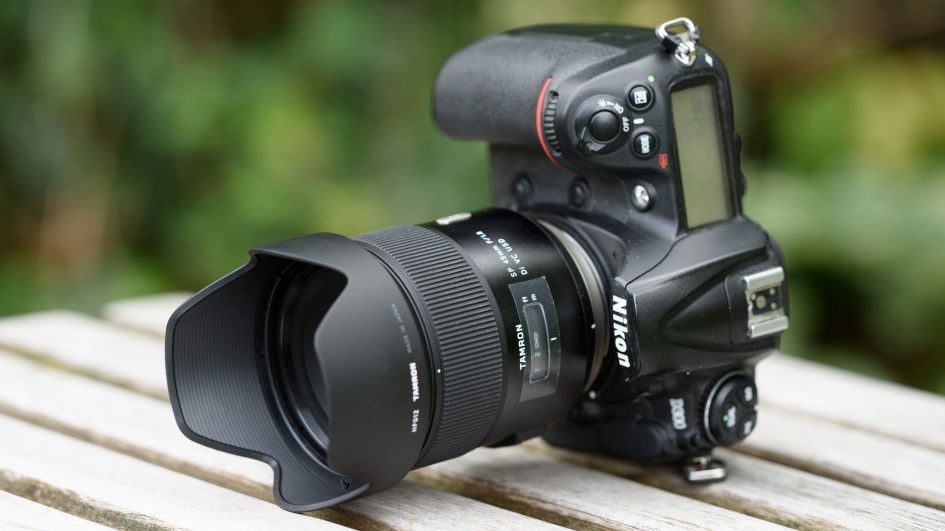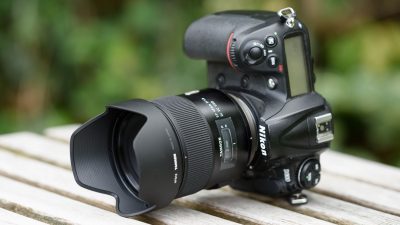Tamron 45mm f1.8 VC review
-
-
Written by Thomas
Verdict
The Tamron SP 45mm f1.8 Di VC USD is an interesting addition to the increasing choice of large aperture standard lenses: it combines very good performance with image-stabilization that adds 2-3 stops of hand-hold-ability to its f/1.8 aperture. With this lens you can shoot under low-light conditions hand-held that you could not cover with a larger and heavier non-stabilized 50mm f1.4 lens – unless you crank up ISO by 1.33 stops. And its focal length is 10% shorter than the typical standard lens for full-frame sensors that start at 50mm focal length and go up to 58mm. So it’s closer to the “ideal” standard-lens which should have a focal length identical to the diagonal of the sensor which would be 43mm. This allows you to capture more of a scene than with a 50mm lens.
But the new Tamron has some deficiencies too: the Bokeh of the lens is not the best around and it produces some visible longitudinal color aberrations and magenta ghosting. Those weaknesses need not always occur under normal shooting conditions, they are more likely to show up in high-contrast situations. And they are better controlled than on Tamron’s 35/1.8 VC. But still they can be distracting and are not easy to remove in post-processing.
Now let’s see how the new lens compares to the competition.

Compared to Nikon AF-S 50mm f1.8G
For Nikon users the Nikon 50/1.8G is perhaps the most obvious alternative. At only 170 EUR it’s much cheaper than the Tamron, plus smaller and lighter. It earned a Highly Recommended in my Nikon 50/1.8G review, but that was tested a while back on a D300 and D700. On a 36MP full-frame body the lens is more likely to earn a Recommended. It does not have image stabilization, which puts it at a 2-3 stop disadvantage over the new Tamron. Optically the Tamron produces better results but the Nikon 50/1.8G is also quite good. So the higher price of the Tamron gives you the image stabilization which might just be the thing you needed to get a sharp shot under low-light conditions plus a better optical performance.
Compared to Nikon AF-S 50mm f1.4G
A step-up in price, size, and weight over the Nikon 50/1.8G is its bigger brother the Nikon AF-S 50mm f1.4G. It is still less than half the price of the Tamron and offers a 2/3 larger maximum aperture which is good for two things: you can shoot at shorter shutter speeds than with the Tamron and it produces the better Bokeh. But the Nikon renders softer and less contrasty images even at f2.0. And did I mention that the Nikon 50/1.4G does not have image stabilization? In my Nikon 50/1.4G review the lens earned a Highly Recommended, but that was an older review on a D300. With newer test-shots on a D800 the overall performance is more likely to earn a Recommended. But if you’re in for a creamy Bokeh and a soft rendering, the Nikon 50/1.4G certainly makes a difference.
Compared to Sigma 50mm f1.4 “Art”
The Sigma 50/1.4 Art is perhaps the most direct competitor for the new Tamron. It almost costs the same and offers a 2/3 of a stop larger maximum aperture but has no image stabilization. So you have to decide what is more important for you: The offer to hand-hold 1/8 sec which may just be what you need to shoot in dimly lit interiors or in fading light outside from the Tamron. Or the possibility to to get almost 1 stop shorter shutter speeds to better fight motion-blur in moving objects or people plus a better isolation from the background with the Sigma. Optically the Sigma renders sharper and more contrasty than the Nikon 50/1.4G and comes very close to the Tamron. In my Sigma 50/1.4 Art review the lens earned a Highly Recommended.
Compared to Zeiss 55mm f1.4 Otus
This lens is the optical benchmark for standard full-frame lenses. In my Zeiss 55/1.4 Otus review the lens easily earned a Highly Recommended. But: it is manual focus only and carries a hefty price-tag of 3500 EUR. These two factors make the Otus less likely to be a real alternative to the Tamron, but it is still interesting to compare the performance. The Zeiss Otus excels with sharp images almost free of color aberrations and coma right up into the FF/FX-corners near and far. I really only found two issues with the Otus: its price and the missing AF. The new Tamron comes closer to the sharpness / resolution of the Otus than any other lens in this comparison. But the Tamron shows quite some color aberrations and a slight weakness at the border of the APS-C/DX image circle at long-distance shots. Plus it has a weaker Bokeh.
Compared to Nikon AF-S VR 24-70mm f2.8E ED
A zoom as an alternative to a fixed focal? Well, you lose 1.3 stops of maximum aperture but you gain much in flexibility regarding the right framing of an image where you cannot or don’t want to “zoom with your feet”. And the image quality of a modern zoom can be quite convincing. The 24-70/2.8E VR Nikkor is the newest lens in this comparison. Nikon finally integrated an image stabilization (VR) into their professional workhorse zoom. And a very good one at that: the VR in this lens is good for 3-4 stops of hand-holding power, which easily compensates for the 1.3 stops between f/2.8 and f/1.8 maximum aperture. But although at 2500 EUR it is more than three times as expensive as the Tamron 45/1.8 VC it cannot match the image quality of the fixed focal (see my Nikon 24-70/2.8 VR review). It is also a very big and heavy lens. So there’s a price to be paid for flexibility: literally and in the form of image quality, size, and weight.
Tamron SP 45mm f1.8 Di VC USD final verdict
The new Tamron 45/1.8 VC is a very versatile and interesting lens: It offers a fast f/1.8 aperture combined with image-stabilization that is good for two stops in my tests. Both allow the lens to hold out longer in dimly lit situations. It produces very sharp images with very little coma right into the corner of a full-frame sensor. And it’s relatively small and light. But it does not produce the same Bokeh as a 50/1.4 or 55/1.4 lens and it has color aberrations which show up although not as prominent as with Tamron’s 35/1.8 VC. But with a sharpness / resolution that it is better than any other lens in this comparison apart from the Zeiss Otus the Tamron 45/1.8 VC clearly earns a Highly Recommended. Regarding this performance the price of the new Tamron seems OK. And I’m really looking forward for Tamron to design a 85mm f1.8 VC lens!
PS – don’t forget you can support my work next time you order anything at Amazon, B&H or Adorama by first clicking through to them using the links above and in the sidebar. It works for anything you order at any time – thanks for your support!
Summary
Good points:
- Very good quality across the full-frame area.
- Weather sealing.
- Quiet and fast AF operation.
- Good image stabilization.
Bad points:
- Longitudinal CAs and purple ghosting.
- Not the best Bokeh.




